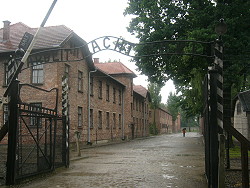
Photo. Entrance to hell: Auschwitz, with the sign above the gate displaying the text: Arbeit mach frei (work liberate you). The complex consisting of Auschwitz I, Auschwitz II (Birkenau) and Auschwitz III (Monowitz) is the largest Nazi extermination camp.
Auschwitz represents the industrialization of murder. It was dehumanization on an unimaginable scale. At Auschwitz, prisoners were treated not as people but as objects. The Nazis radically changed its purpose of concentration camps, by transforming from sites of political imprisonment to a vast machinery aimed at enforcing racial ideology. This shift is key to understanding how the Holocaust, the genocide of six million Jews. Over time the Nazi regime’s policies varied in both scope and method, depending on how they viewed the threat each group posed to their vision of a racially pure, ideologically loyal society.
Learning from history
We can`t change the history, but we can learn from the history and make the world a better place to live for us all. In the last 30 years, Holocaust awareness in Norway has increased in both the educational sector and society in general. The story of Holocaust has become very important in the Norwegian educational system, covered in schoolbooks and films.
It has also become more common for schools to organise study trips to former extermination and concentration camps in Germany and Poland, such as Sachsenhausen, Ravensbrück, and Auschwitz. Totally 1.130.000 visited Auschwitz-Birkenau previous year (2008). Among them, 32.100 where from Norway, most of them pupils from schools. Inspired by the White Buses program during the Second World War, The Norwegian White Buses Association started in 1992 to organise excursions for school classes to concentration camps. Schoolchildren are there guided aorund by first-hand witnesses and survivors.
"White Buses" refers to a program undertaken by the Swedish Red Cross and the Danish government in the spring of 1945 to rescue concentration camp inmates in areas under Nazi control and transport them to Sweden, a neutral country. Although the program was initially targeted at saving citizens of Scandinavian countries, it rapidly expanded to also include citizens of other countries. The program removed 15,345 prisoners from mortal peril in camps; of these 7,795 were Scandinavian and 7,550 were non-Scandinavian. The term "white buses" originates from the colour of the buses. The were painted white with red crosses to avoid confusion with military vehicles (source: Wikipedia).
According to a Press Release from the Norwegian Ministry of Foreign Affairs, Norway will donate $ 312,000 to the preservation of the memorial museum at the Nazi German Auschwitz-Birkenau death camp in Poland. “Auschwitz-Birkenau is perhaps the most important museum in Europe. This site tells a story that we are not allowed to forget,” said Norwegian Foreign Minister Jonas Gahr Støre, at The International Task Force Holocaust meeting in Oslo on 24 June 2009. Here you can read the speech by Støre.
In March 2009, Norway assumed chairmanship of the 26-nation Task Force for International Cooperation on Holocaust Education. Poland has proposed the creation of an international fund of 120 million Euros for the maintenance of the camp.
Children of Holocaust
One of the most heartbreaking and symbolic reminders of the horrors of Auschwitz is the collection of children's shoes displayed in the memorial museum. The sight of thousands of children's shoes, left behind in piles, evokes a powerful emotional response. These shoes belonged to the youngest and most vulnerable victims — infants, toddlers, and school-age children. Most of these children were murdered upon arrival at Auschwitz, without ever having a chance at life. The shoes symbolize innocence stolen and serve as a tangible reminder of the individuals lost, each pair representing a life that was shortened.
The shoes, along with other personal items such as eyeglasses, suitcases, and prosthetic limbs, serve as haunting relics that create a direct connection between the present and the past.
Holocaust is a history of enduring horror and sorrow. Children were especially vulnerable in the era of the Holocaust. The Nazis advocated killing children of “unwanted” or “dangerous” groups in accordance with their ideological views, either as part of the “racial struggle” or as a measure of preventative security. The Germans and their collaborators killed children both for these ideological reasons and as a revenge for real or alleged partisan attacks.
The Germans and their collaborators killed as many as 1.5 million children, including over a million Jewish children and tens of thousands of Romani (Gypsy) children, German children with physical and mental disabilities living in institutions, Polish children, and children residing in the occupied Soviet Union. The chances for survival for Jewish and some non-Jewish adolescents (13-18 years old) were greater, as they could be deployed at forced labour.
It drives me crazy thinking about what happened to people in Auschwitz and other concentration camps, especially the children. It made me even worse reading the controversial British researcher and author David Irving`s allegations. Irving has affirmed that he never denied thousands of Jews and others died under the Nazis, but he has repeatedly denied that anyone died in gas chambers at Auschwitz. He has also called this concentration camp a "Disneyland" created by Polish Communists to attract tourists.
This article continues in Part 3.
Stein Morten Lund, 30 June 2009
Additional information
The term "concentration camp" wasn't invented by the Nazis. It refers to camps where people are "concentrated" or gathered in one place, often against their will, as a means of controlling or punishing them. This term had been used in other contexts, such as the British in the Boer War (1899-1902) and the Spanish in Cuba (1896-1898). The Nazis adopted the term, but they radically changed its purpose, turning it into a system of terror, control, and ultimately, genocide.
“Those who cannot remember the past are condemned to repeat it.” – George Santayana, The Life of Reason, 1905. From the series Great Ideas of Western Man.
